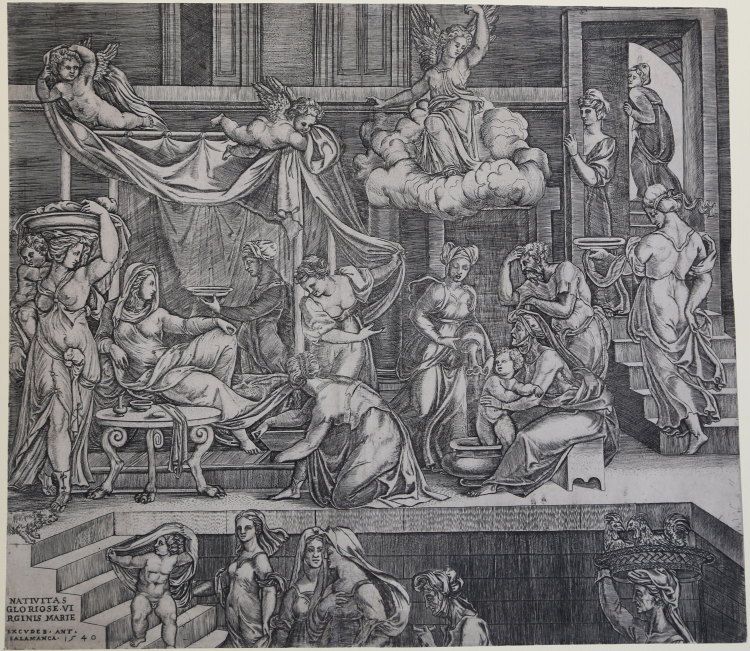



| Reference: | S30312 |
| Author | Agostino de Musi detto VENEZIANO |
| Year: | 1540 |
| Measures: | 435 x 382 mm |


| Reference: | S30312 |
| Author | Agostino de Musi detto VENEZIANO |
| Year: | 1540 |
| Measures: | 435 x 382 mm |
Engraving, circa 1530, dated on plate. Example of the second state of four with the date 1540 and the address of Salamanca. A good impression, printed on contemporary laid paper, irregularly trimmed at the platemark, perfect repaired areas in the central part, otherwise in very good conditions.
The engraving appears to be a copy of the work of Beatricetto, after a drawing of Baccio Bandinelli, as stated in the inscription that accompanies it : Bacius Floreninus Inventor.Nicolaus Beatricius Ltharingus restituit.
The work of Bandinelli, now in the Uffizi in Florence, in all probability was to be a preliminary sketch for the bas-relief at the Basilica of Loreto. This first project was later modified. Always in the Uffizi, it keeps a second preparatory drawing much closer to the bas-relief. The first project was, however, remained to be reworked - with several expansions - in engraving. The composition is on two levels, in a style that shows a preference Bandinelli in his designs for engravings, just think of the Martyrdom of Saint Lawrence engraved by Marcantonio Raimondi. The scene is crowded: in a big room, around St. Anne, mother of the Virgin, several women are bustling in different duties and responsibilities, others rush from the lower floor, via the stairs in the foreground, while the background to the right, a woman looks out of the door. The technique used by this anonymous engraver is full of sharp lines which serve to emphasize the profiles and contours. At the beginning of the century, a similar technique was used by Giovanni Jacopo Caraglio, from which the engraver was probably affected. Is advanced by some scholars the name of Agostino Veneziano that we have also impacted by the inventions of Baccio Bandinelli.
|
Bartsch XV.13.1; TIB 28.010 S2; C. Witcombe, Print Publishing in Sixteenth – Century Rome, p. 249.
|
Agostino de Musi detto VENEZIANO (Venezia 1490 ca. - Roma 1536/38)
|
Heir of the great tradition of the Raimondi’s, Agostino Musi, from the family de Masyus or dè Musis, also known as the Veneziano, derives his nick name from the city where he studied the “giorgionesco” style of Giulio Campagnola, di Jacopo dè Barbari and Dürer.
For a while, Agostino lived in Florence translating works from Andrea del Sarto. After that, he moved to Rome where he started working in the workshop of Bavero di Carrocci (aka Baviera) from 1516 till the Sack (Sacco) of the City.
After the Sack, he very likely went back to Florence and maybe Mantua, where he worked on Giulio Romano’s production. Between 1530 and 1531 Agostino went back to Rome and engraved the marvellous Vasi antichi e moderni, with the coats of arms of Clemente VII de Medici; in this work it can be seen his own, peculiar, ornamental style, which he used to realize splendid works for the first, great Roman publisher, Antonio Salamanca.
Bartsch ascribes to him 181 prints, dated between 1509 and 1536; Passavant then added other seven subjects (VI, pp. 49-68).
|
|
Bartsch XV.13.1; TIB 28.010 S2; C. Witcombe, Print Publishing in Sixteenth – Century Rome, p. 249.
|
Agostino de Musi detto VENEZIANO (Venezia 1490 ca. - Roma 1536/38)
|
Heir of the great tradition of the Raimondi’s, Agostino Musi, from the family de Masyus or dè Musis, also known as the Veneziano, derives his nick name from the city where he studied the “giorgionesco” style of Giulio Campagnola, di Jacopo dè Barbari and Dürer.
For a while, Agostino lived in Florence translating works from Andrea del Sarto. After that, he moved to Rome where he started working in the workshop of Bavero di Carrocci (aka Baviera) from 1516 till the Sack (Sacco) of the City.
After the Sack, he very likely went back to Florence and maybe Mantua, where he worked on Giulio Romano’s production. Between 1530 and 1531 Agostino went back to Rome and engraved the marvellous Vasi antichi e moderni, with the coats of arms of Clemente VII de Medici; in this work it can be seen his own, peculiar, ornamental style, which he used to realize splendid works for the first, great Roman publisher, Antonio Salamanca.
Bartsch ascribes to him 181 prints, dated between 1509 and 1536; Passavant then added other seven subjects (VI, pp. 49-68).
|